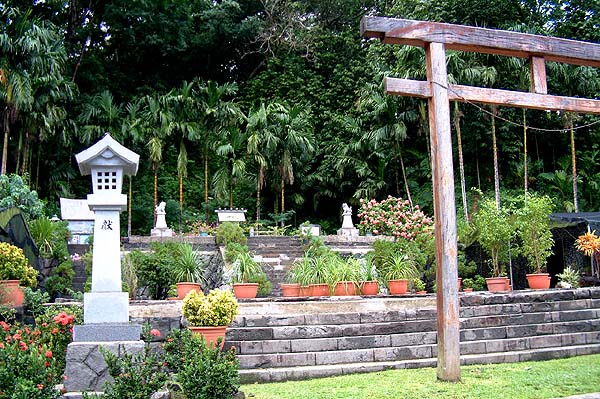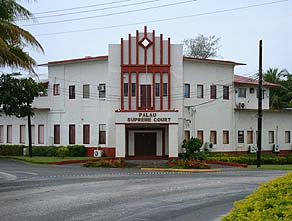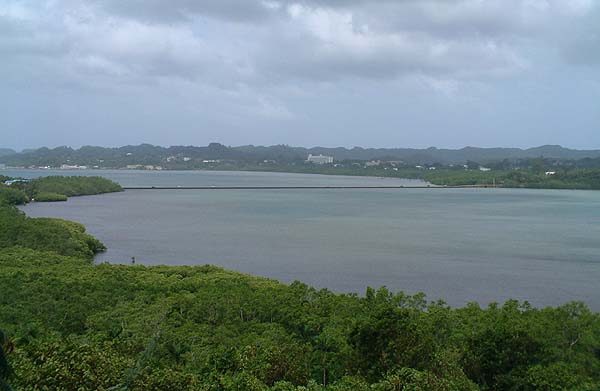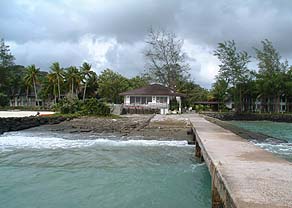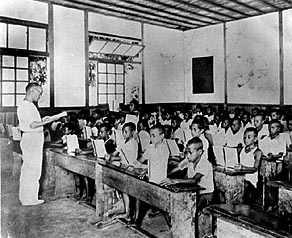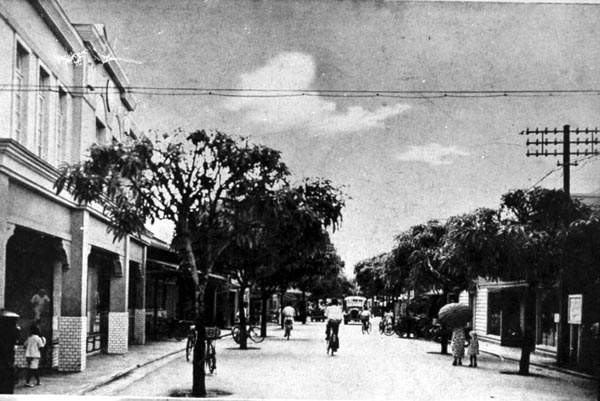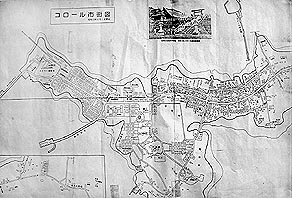 |
 |
 |
 |
||||
|
|
|
|
|
|
|
|
|
|
|
|||||||
|
|
|
|
Shinto shrine in Ngermid hamlet, Koror.
|
|
“The Japanese were very
industrial,” Johnson says. “They
industrialized Palau. They brought thousands of people here—Koreans
and Japanese and Okinawans—to cultivate this place. They were
mining bauxite on Ngardmau—if you go there today you see the strip
mining and the cable cars’ remains on Ngerdmau. In Anguar, it
was phosphate."
|
||
|
|
||
"And they had several Japanese farming communities. In the valley here, where the river is, there was Nanbong—a Japanese farm—and if you go to Ngchesar its Shiramisu. If you go to Ngiuál it’s called Taiyo. These were Japanese farming communities, big communities. They were exporting pineapple, and sugar cane—you name it. And they had fishing boats making the Japanese smoked fish.” “The Japanese were land grabbers,” adds Rurecherudel.
|
|
|
“The Japanese really made this place flourish,” Kathy affirms. “The development you see now is nothing in comparison to the Japanese era. This was mini-Tokyo: there were houses and shops, in Koror especially. "All the way out in Babeldaob was farming. There were pineapple canneries, sugar cane processing plants, tuna canning, tapioca being processed for starch. There were maybe five big farming areas in Babeldaob now that were started by the Japanese."
|
|
|
|
|
| “The Japanese brought in a whole lot of Japanese, and a whole lot of Okinawans who did most of the infrastructure work—the causeways were all built by Okinawans, and Koreans. And they were third, fourth class. So the Japanese fortified the whole island, and just occupied the whole place. “The Japanese put in a lot of infrastructure but they all were bombed out. It was nice though. A lot of the causeways were built by the Japanese, and the seaplane ramps. The seaplane ramp was used until the 1960s when we had the big jet airplanes come here.”
|
||
|
|
||
"There was strict order. No Palauans were allowed to drink alcohol. So they would sneak in the sake. (We had our own alcohol we were brewing, but it was easier just to get it from your Japanese friend or something like that.) “But the Japanese colonization changed the place. It really did change the place, and the attitude of the people. I ask my father. My father criticizes me, he sort of makes fun of me, because back then the education level for every Palauan was three years, and you learned to read and count in Japanese, and you learned a little geography. ‘Geography’ meaning you had to know where Japan is, where the emperor is. Everything relates to the Rising Sun."
|
|
|
"They had to get up in the school and pledge allegiance to Japan and the Emperor. Just Palauans and Japanese, and there were two different schools for them. And my father said, ‘after three years in Japanese school, I can speak Japanese and I can write the two different kind of Japanese characters. I can use the abacus and do math calculations. But today, after twelve years of school, you hardly speak English!’ “The language in school was just Japanese. Purely Japanese. We were discouraging from speaking Palauan in school. You had to speak Japanese. If you spoke Palauan, you’d get punished: stand in the sun, or your hands get slapped, or you’d do hard work.”
|
|
|
|
|
“When Japanese were occupying Koror and the rest of Babeldoab island," Walter relates, "they started building roads on Babeldaob island. This is before the war. I don’t know if they knew the war was coming—of course they knew, because they were involved in WWI. They went to Airai State, and they built a road through the area. They treated it like it was like a no-man’s land. They destroyed good taro patch areas; some of the good family lands that were over there, the roads that they laid would just split them in half. "That impact remains until today. After the Japanese, all the new governments that came just followed the same path, and the people never really get back those properties that they lost. It became sort like a public domain."
|
||
|
|
||
“When they went by the villages, they didn’t have much resources, so the Japanese used all the resources available on the island. They tore down all the traditional platforms along side, building the road to Babeldaob and to the center of Airai State. They robbed some of them. And even making the bunkers, they robbed the stone platforms. "Near where the road comes from the KB Bridge was one of the traditional villages, called Ngerechemel. It was a very powerful village in olden days, and they had a lot of sub-villages under them. It was by the road they were building. And there used to be a chief of Ngerusar who told how Japanese were robbing those platforms, the village platforms of Ngerchamel, to build the road. And further up, too. And in those days the platforms weren’t important for the Palauan people, who had been brainwashed."
|
The road in Airai State cuts right through taro land.
|
|
“Airai was the closest big land mass to Koror, and they penetrated even the center of Airai State. You can see those Japanese building there today. They developed Koror, and parts of Babeldaob, almost to the fullest. Then they used all the natural resources available here. "This is the map over here this is how developed Koror was. It was almost the same in Airai too: there were a lot of houses in areas over there, especially family cottages. You can still see the foundations, steps to the houses, almost everywhere over there. You go to the boonies, you seen remains. We don’t enough population these days to built to that extent, to those areas.”
|
|
|
|
"And they were building the airport over there, preparing for the war too, and just flights from Japan to Palau. Peleliu, Angaur, and Airai. They built those, and fortified that part of Airai too."
|
||
|
|
||
|
|
|
|
|
|

|
| Airai Home | Map Library | Site Map | Pacific Worlds Home |
|
|
|
|

|
|
|
|||
| Copyright 2003 Pacific Worlds & Associates • Usage Policy • Webmaster |
|||
